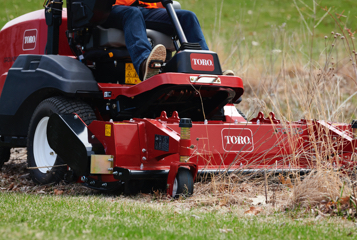- CONTACT US
- MOWERS
- VEHICLES
- APPLICATION
- Golf
- AERATORS
- VEHICLES

NEWS FOR COUNCILS, CONTRACTORS AND LANDSCAPERS
NEWS FOR COUNCILS,
CONTRACTORS AND LANDSCAPERS

IN THIS ISSUE
ALL STORIES

Stage V
for cleaner air
Share this story: Twitter | Facebook | LinkedIn
For years, engine and machinery manufacturers across the outdoor power equipment industry have been working towards lower exhaust emissions and cleaner air. 2019 saw the biggest developments yet for non-road mobile machinery with the introduction of Stage V emissions regulations in the European Union.
Here we talk to Chris Cooper, senior product marketing manager at The Toro Company, about what this legislation means for turfcare customers in the UK.

Chris, thanks for taking the time to chat with us. To set the scene, perhaps you could start by recapping what Stage V compliance is?
Stage V refers to exhaust emissions standards introduced by the EU for non-road mobile machinery using spark ignited and compression ignition engines.
For diesel engines in particular, Stage V will limit the amount of particulate matter produced in an effort to reduce air pollution. As governed in the regulation, production of new machinery fitted with an engine and destined for the European market will, if produced after 30 June 2020, need to comply with the Stage V standards. Specific to diesel engines with power rating between 19 kW and 560 kW, this will require the addition of a Diesel Particulate Filter (DPF) in order to comply.
Machinery produced before this date, providing they have been placed on the market, i.e. in dealer or distributor inventory, avoid any restriction on when they can be retailed to an end-user.
Stage V closely follows the Tier IV standard that was introduced in North America several years ago. While there are similarities, Tier IV and Stage V are two different standards.

Chris Cooper
Senior product marketing manager, The Toro Company
What is the difference between Stage V and previous EU emissions standards?
It’s an evolution of previous standards and requires controls to be applied to new non-road mobile machinery. It will ensure limitations of carbon monoxide, nitrogen oxides and hydrocarbons, as well as diesel soot emitted to the atmosphere.
The biggest change with Stage V from previous standards is that it captures all spark ignited (SI) and combustion ignition (CI) engines, where previous standards did not.
What impact do these regulations have for the customer?
The essence of the regulations are, of course, good – cleaner air is something we should all be supportive of and active in achieving, but the fact of the matter is these changes do have a significant effect on the product, particularly those with diesel engines rated above 19kW and fitted with DPF systems.
The engines are more complex and follow the type of engine management systems that we associate more with the automotive sector. However, diesel engines in the sub-19 kW category, and SI engines witness much less of an impact, which prompts manufacturers to look at whether a product can meet customers needs with less horsepower or migrate to alternative fuels.
We’re expecting a period of uncertainty with customers as they assess the way they maintain their grounds/contracts, considering requirements, mowing options, budget, etc. It will become crucial to consider the ‘real mowing’ productivity of the machine, something tenders have already started to add into the process.
For example, is there a different way to compile a fleet or can different purchasing decisions be made that allow customers to remain profitable and productive? It might cost more to buy a specific machine but if you only need to buy one machine to perform more than one function or a machine like the Toro LT-F3000 triple flail, which is so productive it can enable you to reduce the cutting frequency, those factors become more important than ever.

What has Toro been doing since it knew these changes were coming?
Toro benefitted from its experience with the roll-out of Tier IV products in North America. We learned how to design out inefficiencies in systems such as, but not limited to, hydraulics, engine cooling, etc. We’ve focused on how we can deliver a range of efficient, capable solutions to our customers, so they can select the right machine for their requirements.
For example, we have reduced the horsepower of our CT2240 compact triple from 19kW to 18.7kW, a reduction of only 1.5 percent, but a reduction that allows us to avoid the added cost and complexity of a DPF filter. Despite the reduced power output compared to its bigger brother, the LT3340, the CT2240 offers many of the same features, the same width of cut and will also, [for 2021] be available with the larger 250mm (10ins) diameter cutter units, which were previously limited to the LT3340. We feel this offers the customer an interesting value proposition – will they be willing to accept a product that can achieve over 80-90 percent of what the LT3340 can, and benefit from the simplified power train and lower cost? Less horsepower could also result in lower fuel consumption and lower operating costs.
Stage V will certainly shake-up the market, so it’ll be interesting to see how customer requirements and preferences adapt and change over the coming months and years.
In contrast we’ve upped the power of the Toro LT3340 heavy-duty triple mower from 26kW to 27.5kW, giving customers the option to buy a machine that can now do more. If customers are having to pay more, we will always strive to provide them more features and benefits in return. The LT3340 is a classic example of that.

Some of our latest products such as the Groundsmaster 3000 series, the ProLine H800 direct collect out-front rotary, and the ProStripe pedestrian mower are already Stage V compliant and already sought-after in the UK.
The new Groundsmaster 3000 has been designed with the option of a flail attachment which means you can cut two ways with one machine. That is a design function similar to the LT-F3000 which has made that particular machine so popular. Basically, we’re at the start of a process which will see very different customer behaviours by the end.
What happens to a machine with a non-Stage V engine?
That’s a good question. Engine manufacturers are able to supply replacement non-Stage V engines for up to ten years from when the Stage V standard was implemented.
For machinery purchased before Stage V was enforced, they can continue to be used as normal – the regulations only affect new machinery that has been manufactured after 30 June 2020. Machinery fitted with a non-Stage V engine and not yet placed in the EU market would not be allowed, except when making use of a transition engine.
How can customers tell whether a Toro product is Stage V compliant?
All compliant engines are labelled to reference the emissions certification to which they comply. For products such as the Toro LT-F3000 for example, we are issuing a new model number to distinguish the Stage V models from non-Stage V models, thereby increasing traceability.
What are the dates of which customers should be aware?
Production of machinery fitted with non-Stage V, transition engines will cease on or before 30 June 2020. From this date on, all new machinery production that is destined for the EU must comply with the Stage V regulations. Any remaining non-Stage V machinery must be placed on the EU market, i.e. with dealers, distributors, on or before the end of 2020 (31 December 2020) whereby it can be retailed to end-users without any limit on date.
Stage V engines must be used in new, non-road mobile machinery that are produced on or after 1 July 2020.
What is a transition engine and what is a transition machinery?
A transition engine is a non-Stage V engine built before 1 January 2019, which is installed in machinery before July 1, 2020. That machinery is in turn considered transition machinery and must be placed on the EU market before 1 January 2021.
Should we assume the UK market will follow the EU laws moving forward?
At this time there is a lot of uncertainty over what will happen in the future with regards to UK legislation and standards post-BREXIT. For now, however, the UK must follow the EU rules, at least until the end of 2020. Beyond that time, it would depend on the trade agreement with the EU. It is possible that additional administrative requirements may apply in the UK, but at this moment it is the intention of the UK government to continue to follow the EU requirements.
FEATURED STORIES

Stage V for cleaner air
2019 saw the biggest developments yet for non-road mobile machinery with the introduction of Stage V emissions regulations in the European Union.
Here we talk to Chris Cooper, senior product marketing manager at The Toro Company, about what Stage V means for turfcare customers in the UK in 2020.
READ FULL STORY >
Machine Focus: Groundsmaster 3300
Stage V is a hot topic ahead of transitioning this summer and the Groundsmaster 3200 and 3300 lead the first wave of new Stage V emissions compliant machines from Toro.
Not only do these machines deliver on the new emissions standards but on the new ways councils and contractors are cutting.
READ FULL STORY >
Living wall wins
Maintenance of one of Europe’s biggest vertical living walls next to a Metro line in Birmingham can only happen at night just twice a year.
Unique, progressive and innovative, it was the winning project for Nurture Landscapes in Toro and Reesink’s sponsored BALI award.
READ FULL STORY >Reesink UK LTD | 1-3 Station Road, St Neots PE19 1QF | Registered in England
Reesink UK LTD is authorised and regulated by the Financial Conduct Authority.








